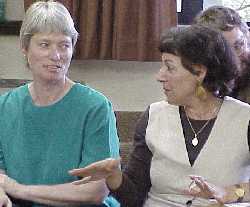A
New Psychology of Women
Gender, Culture and Ethnicity ~ Third Edition |
Feminist
Studies Display

Art: U. of Canterbury
|
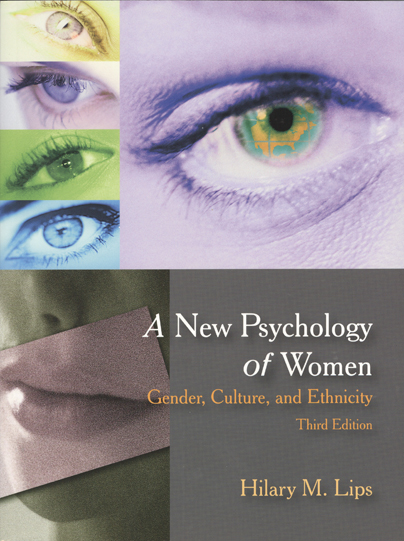
|

Art: U. of Canterbury
|
"Peering into the Kaleidoscope"
Cross-cultural
Perspectives in the Psychology of Women & Gender
by
Professor Hilary M. Lips, Ph.D.
1999 Fulbright NZ-U.S. Award Recipient
at the
University of Canterbury
Copyright © 1999 H. Lips. All rights reserved
March 13th, 1999
|
Presentation
Summary:
Thank you, Dr. Jaber for your introduction. Let me begin by saying
how very pleased and honored I am to be here and to be a part of the
process of looking at the very important issues surrounding women
in education. I offer my thanks to Dorothy Meyer, who spearheaded
this visit, and to all of you for your hospitality. I'll begin my
talk today, with a brief overview of four very remarkable women.
|

Dr.
Lips Introduction by Dr. Nabila Jabber:
Feminist Studies -- University of Canterbury
|
*
Amelia Edwards
In 1873, Amelia Edwards, a redoubtable
Englishwoman, published an account of her travels through the Dolomites.
The book, Untrodden Peaks and Unfrequented Valleys, documents
her journey with another woman -- on foot and on horseback -- through
terrain that was rough and uninviting to travelers, particularly women
travelers. At a time when most English gentlewomen led sheltered,
even uneventful lives, Amelia Edwards craved and found adventure in
her explorations of the world around her. Not content with the vision
of the world that she had inherited as a white Victorian woman of
comfortable means, she traveled the globe with her women friends to
gain and communicate new perspectives.
Ms. Edwards was an ardent advocate
of women's rights. She correctly intuited that women needed to step
out from the protective shelter of their own families -- even their
own country and culture -- to undertake their own journeys and gather
their own experiences, if they were to develop a sense of independence
and strength. Amelia Edwards followed her own advice: she forged an
exciting life as an adventurer, travel writer, and archeologist. She
journeyed to remote corners of the world, wrote well-received novels
and travel books, rose to prominence as a lecturer in Egyptology.
As one of the very few women of her times to try to gain a "global
perspective," surely she is an appropriate pioneer to place at the
beginning of this lecture.
* Bessie Coleman
In 1921, Bessie Coleman earned
her pilot's license. Born, not to privilege, but to poverty, she had
spent the early years of her life picking cotton and living in a three-room
shack in east Texas -- an unlikely start, perhaps, for the world's
first African-American female aviator. It was while she was working
as a manicurist in Chicago that she began to dream of flying. When
no one in that city would teach her to fly, she raised the money to
travel to France. There she studied at one of the best flight schools.
She became a glamorous and daring flyer, drawing large crowds when
she performed in air shows. She died tragically at the age of thirty-four
when she fell from her plane as it nosedived toward the ground. She
had been preparing for a flying exhibition in Jacksonville, Florida.
Bessie Coleman, who could barely
write, left few records of her accomplishments or of her thoughts
and feelings about her flying career. Because she was African-American,
mainstream newspapers of the day gave her exploits little coverage.
After her death, her accomplishments faded into obscurity for many
years. In 1996, she was recognized again after many years of invisibility,
and was featured on a 32-cent U.S. postage stamp. As a woman who insisted
on seeing the world from a new perspective, in defiance of the restrictions
associated with her race, class, and gender, Bessie Coleman too is
an appropriate ground-breaker to place at the opening of this talk.
*Mae Jemison
In 1992, Mae Jemison blasted off
on the space shuttle "Endeavor," becoming the first African-American
woman to travel into space. As a child growing up on the south side
of Chicago, she had watched the stars in awe, dreaming that someday
she would visit them. Her route to the stars took her through a host
of high school science projects, university training as a chemical
engineer, training in choreography and dance, a medical degree, a
stint in the Peace Corps in Thailand. Through it all, she learned
to think of her life as a journey, and not to limit herself because
of anyone else's limited imagination.
Jemison, a modern-day explorer
who now spends a good deal of her energy encouraging young women to
expand their horizons, sees the world as a small and interconnected
place. Viewed from space, the earth presents a face that inexorably
calls forth a global perspective. As one of the few women who has
seen that face, Mae Jemison too is a good model for the beginning
of this lecture.
* Rigoberta Menchú
In 1992, at the age of 33, Rigoberta
Mench£ was awarded the Nobel Peace Prize, praised by the Committee
for standing "as a uniquely potent symbol of a just struggle." A Mayan
Indian of the Quich‚ people, Rigoberta grew up in Guatemala, a member
of a family in which her mother was a midwife and healer and her father
was a community leader and organizer. As a child she picked cotton
and coffee beans, and later worked as a maid in Guatemala City. Before
the age of 20, she was involved in her father's organization, the
Committee of Peasant Unity, traveling with him around the countryside
and urging Native American peoples to resist the appropriation of
their land and villages. The struggle proved to be a tragic one for
her family: her younger brother was tortured and burned alive by government
soldiers because of his political activities. In 1980, her father
and 39 others were killed when government troops attacked the Spanish
embassy which they were occupying in a peaceful protest. Three months
later her mother was kidnapped and raped, tortured and killed by soldiers.
Menchú was literally forced
into the international arena by these events. In memory of those killed
at the embassy, she formed the "31 January" organization a group of
peasants, students and workers who organized demonstrations and labor
stoppages to protest government policies. Soon she was wanted for
"subversive activities" and fled to Mexico. She told the world about
the conditions in Guatemala through her autobiography,
Rigoberta Menchú, an Indian woman in Guatemala (1983),
and joined international efforts to protest human rights abuses by
the Guatemalan government. As a woman who was forced by events to
move beyond her own culture and whose activism has encouraged many
others to look beyond their own borders, Rigoberta Menchú, too
is an appropriate symbol to place at the beginning of a talk about
multicultural perspectives on women and gender.
- What do these individuals have in common? They are women
.... They are extraordinary...
- What do they have in common with less remarkable or famous women?
- Do they share more than female biology?
- Do they share certain kinds of restrictions or expectations ....
One of the things that women may
have in common is the quality of the barriers they face. Different
groups of women may vary in the ways in which they experience and
interpret those barriers, in the strategies they adopt for overcoming
them, in how successful they are at transcending them. For instance,
the four women described here shared certain barriers, despite the
dramatic differences in their lives. All faced cultures in which men
were traditionally the leaders, the great explorers, the adventurers.
Women, with fewer resources and surrounded by an ideology that they
should be home-centered, were supposed to wait and worry while men
went out into the world. These obstacles are different in degree,
but perhaps not in kind, from those facing many women of many different
backgrounds.
- What kind of a psychology of women would address the experiences
of all these and other women?
We can look for commonalities and themes, but the differences are
also interesting.  Currently,
we look mainly at white, middle-class U.S. women and men in our courses
on the psychology of women and gender. How can we separate what goes
with being female or male from what goes with being white, middle-class,
American? We cannot. And this makes it look as though certain qualities
or behaviors that correlate with being female or male in this culture
are inevitably linked to sex or to gender. The title for this talk
was suggested by a quote from Australian literary scholar Sneja Gunew:
In trying to grasp the experiences of women from a variety of times
and places, "we should perhaps use the image of a kaleidoscope, where
each turn produces different patterns and no single element dominates"
Sneja Gunew (1991). Currently,
we look mainly at white, middle-class U.S. women and men in our courses
on the psychology of women and gender. How can we separate what goes
with being female or male from what goes with being white, middle-class,
American? We cannot. And this makes it look as though certain qualities
or behaviors that correlate with being female or male in this culture
are inevitably linked to sex or to gender. The title for this talk
was suggested by a quote from Australian literary scholar Sneja Gunew:
In trying to grasp the experiences of women from a variety of times
and places, "we should perhaps use the image of a kaleidoscope, where
each turn produces different patterns and no single element dominates"
Sneja Gunew (1991).
Let's take a look into this kaleidoscope:
Examples: Hima women being fattened up for marriage:
Among the Hima people of western
Uganda, fat is beautiful -- at least for women.  Men measure a woman's attractiveness by her obesity, and a young woman
is prepared for marriage in ways guaranteed to "fatten her up": the
least possible activity and the most possible food. By the time of
her marriage, the young woman may be so fat that she cannot walk,
only waddle. At the wedding, onlookers then will comment on how beautiful
she is, noting with approval the cracks in her skin caused by the
fatness and the difficulty with which she walks. Once married, a wife
is kept fat by consuming surplus milk from the herd -- often coerced
to do so by her husband when she has long past the point of satiation.
The wife leads a life of "leisure." She is assigned no heavy physical
work, rarely leaves home, spends her days in sexual liaisons with
a variety of men approved by her husband. These sexual relationships
cement economic ones: the obese, conspicuously consuming wife is both
a symbol and an instrument of her husband's economic prosperity (Tiffany,
1982).
Men measure a woman's attractiveness by her obesity, and a young woman
is prepared for marriage in ways guaranteed to "fatten her up": the
least possible activity and the most possible food. By the time of
her marriage, the young woman may be so fat that she cannot walk,
only waddle. At the wedding, onlookers then will comment on how beautiful
she is, noting with approval the cracks in her skin caused by the
fatness and the difficulty with which she walks. Once married, a wife
is kept fat by consuming surplus milk from the herd -- often coerced
to do so by her husband when she has long past the point of satiation.
The wife leads a life of "leisure." She is assigned no heavy physical
work, rarely leaves home, spends her days in sexual liaisons with
a variety of men approved by her husband. These sexual relationships
cement economic ones: the obese, conspicuously consuming wife is both
a symbol and an instrument of her husband's economic prosperity (Tiffany,
1982).
Chinese women having their feet bound:
In China, and in the Chinese-American community in the United States,
until the early part of this century, it was common for young girls
to have their feet tightly bound. Small feet, "golden lilies," were
considered a sign of beauty and refinement, so the purpose of binding
them at such a young age was to keep them from growing to full size.
The binding deformed the feet and kept them from developing the normal
strength and flexibility needed for walking -- making it difficult
or impossible for a woman to walk unassisted. However, these women
were not necessarily being prepared for a life of leisure. The average
young Chinese woman looked forward only to an arranged marriage in
which she would hold little status until she produced male heirs,
a marriage in which she would be expected to serve her mother-in-law
and submit to her husband. Her life revolved around the necessity
for obedience -- as a daughter, to her parents; after marriage, to
her husband; in widowhood, to her son (Pascoe, 1990).
Women in North America signing up for surgery:
During the 1980s, cosmetic surgery had become the fastest-growing
medical specialty in North America. At the end of that decade, more
than 2 million U.S. women (1 in 60, according to Faludi, 1991) had
had surgical breast implants. More than 100,000 had undergone liposuction
surgery. 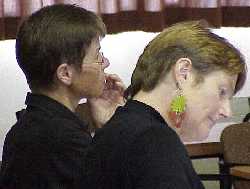 According to one survey, these women were not rich about half made
less than $25,000 per year, and took out loans to pay their surgery
bill. Many women undertook the dangers and heavy costs of surgery
in order to achieve or try to maintain a standard of beauty they felt
necessary for attracting or holding a man. Where did they get the
idea that such drastic measures might be necessary? From millions
of magazine advertisements featuring impossibly-shaped women, and
from the countless "personal" ads in which men specified that they
were looking for a woman who was "attractive and thin" (Smith, Waldorf,
& Trembath, 1990). A representative survey of more than 800 adult
U.S. women in 1995 showed that women held substantially higher levels
of dissatisfaction with their bodies than had been observed in a similar
survey a decade before and nearly half the women reported overall
negative evaluations of their appearance (Cash & Henry, 1995).
According to one survey, these women were not rich about half made
less than $25,000 per year, and took out loans to pay their surgery
bill. Many women undertook the dangers and heavy costs of surgery
in order to achieve or try to maintain a standard of beauty they felt
necessary for attracting or holding a man. Where did they get the
idea that such drastic measures might be necessary? From millions
of magazine advertisements featuring impossibly-shaped women, and
from the countless "personal" ads in which men specified that they
were looking for a woman who was "attractive and thin" (Smith, Waldorf,
& Trembath, 1990). A representative survey of more than 800 adult
U.S. women in 1995 showed that women held substantially higher levels
of dissatisfaction with their bodies than had been observed in a similar
survey a decade before and nearly half the women reported overall
negative evaluations of their appearance (Cash & Henry, 1995).
Young women starving themselves in Argentina:
Maria, an 18-year old Argentine
high school student, became obsessed with being thin after an ex-boyfriend
called her "fatso" in front of her friends. She starved herself for
weeks, and wrapped nylon stockings and plastic bags around her body
to "sweat off" weight. Soon she appeared gaunt and pale, with sunken
cheeks and protruding ribs. She developed black patches under her
eyes from malnutrition, stopped menstruating, and could not tolerate
the sight of food. Finally, she says, "After three months, people
began asking if I had AIDS--I was so glad then. I thought, that means
I'm as thin as a model now. Now I'm beautiful." (Faiola, 1997, p.
A24).
Maria's case is an example of an
eating disorder called anorexia nervosa: an obsession with thinness
and a distorted body image that leads to self-starvation. People who
suffer from anorexia tend to "feel fat" even when severely underweight,
so they starve themselves in order to achieve the thinness they crave.
A related eating disorder, bulimia, is characterized by a pattern
of binge overeating followed by self-induced purging through dieting,
vomiting, or the use of laxative. This disorder too revolves around
an obsession with food and with body weight. Both disorders have,
according to media reports, reached epidemic proportions in Argentina,
where they are jointly known as "fashion model syndrome" and may have
the highest incidence in the world (Faiola, 1997). They are most common
among young, middle-to-upper class women, although the percentage
of male cases has increased in recent years from 5 to 12 percent.
If I were teaching my psychology
of women course now, I would ask my students to look for the common
threads that link these examples. Here are some things I hope they
would notice [OVERHEAD: Slide not available]:
*These very different cultures
all include strong ideas about what it means to be feminine.
*The notions of femininity have
overlapping themes:
--subservience to and dependence on men (especially the husband),
--the importance of beauty,
--restrictions on movement, strength (and other freedoms).
A course that incorporates multiple cultural perspectives can:
--show how certain issues are shared for women in many cultures
--show how certain issues are structured or interpreted
or coped with differently in different times and places.
--help students to understand how interpretations can become "real";
--help us and our students to break out of habits of thought and become
open to new ways of thinking about issues.
So by incorporating multicultural perspectives, we may discover/define/construct
some kind of balance between cultural universals and particulars in
the psychology of women and gender, and provide students with
a appreciation of diversity and a wider knowledge of the world.
I am going to give you examples
of how this approach can be used in four areas. These are areas in
which a reasonable amount of data from different cultures exist, and
which are obvious topics for courses on the psychology of women or
Gender:
*what is meant by gender categories
*gender stereotypes and ideologies
*violence against women
*power and gender
A. What do we mean by gender categories?
-We usually use 2 mutually exclusive categories to define gender
and we divide everyone into one or the other: female or male.
- e.g., what happens when a baby is born with ambiguous genitalia
...
Nothing puts the social construction
of gender in to such sharp relief for us as looking at societies in
which gender in discussed, not in terms of two categories (feminine
or masculine) but in terms of three or more categories. For those
of us who have grown up thinking of gender as a fixed, binary concept,
it may be difficult to imagine a third gender, or to imagine a society
in which an individual's gender is considered fluid or changeable,
or to imagine gender as a continuum instead of distinct categories.
These difficulties of imagination
are exactly the ones that encumbered anthropologists and other chroniclers
of North American Indian societies. When these anthropologist outsiders
encountered individuals in Indian societies who apparently had an
"intermediate" gender status, accomplished by combining or mixing
the attributes and behaviors of females and male, they tried to fit
these individuals into their own culturally-based understanding of
gender.  Thus,
they used terms such as "man-woman" and "halfman-halfwoman" to translate
the Indian terms for such individuals: nadle, winkte, heemaneh.
Yet it now appears that these translations were misleading, limited
by the anthropologists' own notions of gender. Instead, the terms
seem to describe a distinct third gender -- one that is not simply
a mixture of masculine and feminine, but defined separately from them
(Callender & Kochems, 1983; Fulton & Anderson, 1992). The person is
not a man dressing and acting like a woman, nor a woman dressing and
acting like a man, but a man or woman who has adopted a third role
-- that is neither feminine nor masculine. Thus,
they used terms such as "man-woman" and "halfman-halfwoman" to translate
the Indian terms for such individuals: nadle, winkte, heemaneh.
Yet it now appears that these translations were misleading, limited
by the anthropologists' own notions of gender. Instead, the terms
seem to describe a distinct third gender -- one that is not simply
a mixture of masculine and feminine, but defined separately from them
(Callender & Kochems, 1983; Fulton & Anderson, 1992). The person is
not a man dressing and acting like a woman, nor a woman dressing and
acting like a man, but a man or woman who has adopted a third role
-- that is neither feminine nor masculine.
These individuals were not simply
"cross-dressing" (i.e. men or women dressing in the clothing of the
other gender) but were wearing clothing appropriate to their third
gender status: clothing that was a mixture of the items usually worn
by women and men. More important than sexuality seems to be the
adoption of particular forms of work, social habits, dress.
For example, anthroplogist John
Honigman (1954) notes that among the Kaska Indians of the Canadian
subarctic, gender transformations were ometimes necessitated by the
division of labor. They depended on large game hunting to survive.
If a couple had no sons to help them with this task, the performed
a ceremony of gender transformation on their youngest daughter. They
tied the dried ovaries of a bear to a special belt for her, to prevent
her from menstruating or becoming pregnant. These girls grew up developing
exceptional hunting skills, participated as men in the male-only sweat
baths, and were accepted by men on the basis of their activities.
Some anthropologists now feel that
individuals of the third gender, by adopting a role that bridged the
categories of female and male, became regarded as intermediaries for
dangerous passages between categories. Thus, these third gender individuals
often presided over transformational events such as birth, marriage
and death and were highly valued by their communities as arbiters
of continuity in a precarious world (Fulton & Anderson, 1992).
The idea that there can be more
than two genders is not limited to North American Indian societies.
In Samoa, for example, there is a third gender category of person
called fa'afafíne, meaning "the way of women." These are
males who dress in women's clothing and are often included in female
activities. However, these individuals do not "pass" for women, nor
do they follow the rules that are understood to be in place for "proper"
women. Rather, they act as jesters who mock certain gender restrictions
and can violate them with impunity. For instance, a Samoan girl may
whisper some suggestive remark about a passing boy -- perhaps a sexual
comment about some feature of his anatomy -- to a fa'afafíne.
The fa'afafíne not bound by the same restrictions of propriety
as the girl, will then make a loud joke out of her comments, attracting
the attention of the boy (Mageo, 1992).
Other examples of third, or even
fourth, gender categories exist (the hijras of India, the "manly-hearted
women" of some North American Indian groups). Some good references
are included in the list I have give you.
For students, it is interesting
to note not only the diversity in thinking about gender and in the
institutionalization of gender across cultures, but also the ways
in which anthropologist-outsiders reacted to these differences. What
did they see? What did they fail to notice? How was their "seeing"
influenced by their own culturally-based assumptions? For example,
anthropologist Martha Ward (1996) notes that virtually nothing is
known about the women who became the wives of the female chiefs or
"manly hearted women" they were simply taken for granted and ignored
by male anthropologists who "assumed" that anyone taking on the role
of a man needed a wife.
B. Gender stereotypes and ideologies
In Japan, girls are taught from
an early age that femininity involves modesty in speech. The appropriate
and natural speaking style for females, they learn, involves softness
of voice, reticence, extreme politeness, and covering the mouth when
talking or laughing. So well do they learn these lessons that, as
adult women, their speech is often characterized by deference and
accommodation. For example, when one researcher studied the speaking
style of popular television cooking show hosts in Japan, she found
striking gender differences in speaking style. The male host tended
to give authoritative directives to his television underlings, telling
them to "add this to the bowl," or "stir this now." The female host,
on the other hand, was likely to phrase her directive in a more deferential
way, such as "if you would now do me the favor of stirring this" (Smith,
1992).
Every cultural group has its own
version of gender stereotypes: socially shared beliefs that certain
qualities can be attributed to individuals, based on their membership
in a gender category, and gender role ideologies, prescriptive beliefs
about how females and males should behave.
- There is quite a bit of cross-cultural data on these topics, so
it makes a good example and allows us to raise some interesting questions
- U.S. research: More than two decades ago, researchers found
that American university students, asked to categorize 300 adjectives
as being typically associated with women or men, agreed strongly on
a cluster of 30 adjectives for women and 33 for men (Williams & Bennett,
1975). Women were, for instance, described as dependent, dreamy, emotional,
excitable, fickle, gentle, sentimental, and weak; Men were thought
to be adventurous, aggressive, ambitious, boastful, confident, logical,
loud, rational, and tough.
-Cross-cultural comparisons: Researchers in Canada (Edwards
& Williams, 1980) and Britain (Burns, 1977) found similar patterns,
and a study of gender stereotyping in thirty countries showed considerable
cross-cultural uniformity in the patterns of adjectives associated
with women and men (Williams & Best, 1982). Studies of adults in 25
countries showed that six (out of a possible 300)
items were associated with men in every country: adventurous, dominant,
forceful independent, masculine, and strong (Williams & Best, 1990).
Only three were associated with women in every country:
sentimental, submissive, and superstitious. These overheads show the
adjectives that were associated with men and with women in at least
75% (i.e., 19) of the 25 countries studies by Williams and Best.
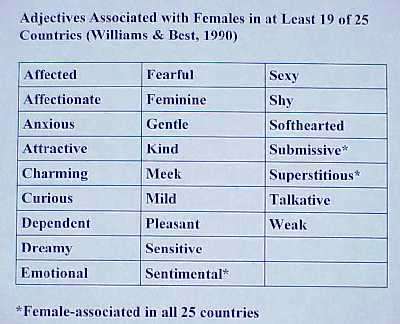
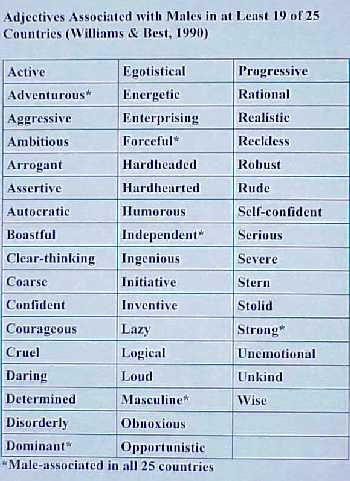
When Williams and Best scaled the
items for affective meaning, along the dimensions of favorability,
strength, and activity, they found the following [OVERHEAD: Slide
not available]:
- no cross-cultural consistency
in the relative favorability of the female-and male-associated traits.
In some countries, such as Japan, South Africa, Nigeria, Malaysia,
and Israel, the male stereotype was associated with considerably more
favorability than the female stereotype. However, in other countries,
such as Italy, Peru, Australia, Scotland, and India, the female stereotype
was most favorable
- in all countries, the male stereotype
items were more active and stronger, and the females stereotype items
were more passive and weaker. These strength and acitivity differences
were greater in countries that were:
- socioeconomically less developed
- literacy was low
- the percentage of women attending
university was low
- when overall differentiation
scores were calculated for the three affective meaning dimensions
combined, there was a lot of variation among countries in this differentiation.
The countries in which the female and male stereotypes seemed to be
perceived as most different were Nigeria, South Africa, Malaysia,
and Japan; they were seen as least different in France, India, Finland,
and Trinidad.
How can we help our students make
sense of the similarities and differences in gender stereotypes and
ideologies across cultures? As students try to form a "right" answer
to the question about the universality of gender stereotypes, I try
to encourage them to step back from that question and the need for
closure on it, and focus instead on how the way we ask research questions
affects the shape of the answers.
For instance some of the possible reasons for cross-cultural similarity:
[OVERHEAD: Slide not available]
Some of the apparent similarity
across cultures may be due to the use of university students -- a
privileged group, often not particularly representative of cultural
attitudes, and often more influenced than others in the culture by
"modern" thought -- in each culture to complete the questionnaires.
Also, university students may be
less representative of the population in some countries than others
as university education is much more available in certain countries
than others, and differentially available to women and men in some
cultures.
Another factor contributing to
the similarity across cultures may be the status difference between
women and men that is common to most of them.. In most cultures, men
are accorded somewhat higher status than women--and researchers have
shown that high-status people are usually judged to be more agentic
(self- and individual achievement-oriented), while low-status people
are judged to be more communal (relationship-oriented; Conway, Pizzamiglio,
& Mount, 1996). This difference parallels stereotypical gender differences.
Some of the things that could contribute to cross-cultural differences:
[OVERHEAD Slide not available]
Domains
Judith Gibbons, Beverly Hamby and
Wanda Dennis (1997) point out that cultures vary in the domains in
which women's and men's roles differ or in the settings in which such
roles are relevant (e.g., marriage, family, employment, education,
politics). If we ask about certain domains we may find cultural differences
but not if we ask about others. And in some cultures we may not know
enough about these domains to ask the right questions. "In order to
develop an instrument with a high level of salience, one would first
need to describe the domains relevant for a particular culture's gender
toles, and then assess beliefs using these ... constructs"
(Overhead: Tibetan example, not available)
Settings.
Some settings are simply irrelevant
in some cultures. For example, as Gibbons and her colleagues (1997)
note, it is no use asking "On a date, the boy should be expected to
pay all expenses" (AWS item) in a setting such as Iran, where dating
does not exist.
Meaning
Setting aside the problem of translation,
which is a major one in cross-cultural research, even within a language,
the same terms may have different meanings for different ethnic groups.
[OVERHEAD: not available]-e.g. Hope Landrine, Elizabeth
Klonoff and Alice Brown-Collins (1995) asked White women and Women
of Color to rate themselves on adjectives taken from the Bem Sex Role
Inventory. The two groups did not differ on their self-ratings on
these items. However, they apparently meant different things by at
least some of the items. For instance, by "passive" the largest percentage
of European American women said they meant "am laidback/easy-going",
while the largest percentage of Women of Color said they meant "don't
say what I really think". And by "assertive" White women were more
likely to mean "stand up for myself" while Women of Color were more
likely to mean "say whatever's on my mind".
Judith Gibbons and her colleagues
(1993) report another example of different meanings assigned to the
same concept. In their research, adolescents from Guatemala, the Philippines,
and the U.S. depicted the ideal woman as working in an office. However,
further analysis revealed that "in the Philippines office work was
associated with glamour, in the United States with routine and boredom,
and in Guatemala with the betterment of the family".
And if the item is not meaningful
at all to the respondent? Gibbons, Hamby and Dennis (1997) have
shown that the less meaningful an item is to respondents, the less
extreme is the response to it on a scale. Thus, "meaningless" items
may contribute to "no-difference" findings. Conversely, they note
that adding items or scales that are developed to be particularly
meaningful to the cultural group under study is likely to result in
more findings of differences.
Besides the similarities across
cultures in the content of gender stereotypes, there are also some
interesting similarities in the variables with which these stereotypes
correlate [OVERHEAD: Slide not available] :
For one things, across a wide range
of cultures, many researchers find that girls hold fewer traditional
gender attitudes than boys do. Is this a universal phenomenon? Not
necessarily, according to a review by Gibbons, Hamby and Dennis (1997).
Researchers have found no gender differences in gender-role ideology
in Malyasia, Pakistan or Spain, and have even found more liberal attitudes
among men than women in samples from Brazil and Dublin.
| |
Judith Gibbons, Deborah
Stiles, and their colleagues have also demonstrated that adolescent
daughters and sons of mothers who work outside the home hold
less conservative gender role attitudes in societies as diverse
as Mexico, Spain, Iceland, the U.S. Similarly, John Williams
and Deborah Best have shown, in their 14-country study of gender
ideology, that idealized gender roles are less differentiated
in societies in which a higher percentage of women work outside
the home and are university-educated (Williams & Best, 1990).
Gibbons, Stiles and Shkodriani (1991) showed that adolescents
from wealthier, more individualistic cultures report less traditional
gender role attitudes than adolescents from poorer, more collectivist
countries. |
Why might such correlations exist?
What variables are confounded here? Scales were developed in wealthy
developed individualistic countries for the most part. These variables
are often confounded with each other and with literacy, education,
employment of women outside the home.
So, what I am trying to show my
students is that researchers have provided some important beginnings
of an answer to the question about cross-cultural variation in ideas
about gender, but that it is important to keep paying attention to
the way that questions are being asked.
C. Violence against women
Agnes, a teacher whose husband
was also a teacher "said the violence began a few years after
she got married, when she caught her husband in bed with a teenage
girl. He began to beat her every evening. He forced her to give him
her paycheck. He called her his slave. For about two years, the violence
eased, but alcoholic rages and financial irresponsibility again became
the norm. And the beatings got worse." Nonetheless, Agnes
did not tell anyone about the beatings, even those closest to her
because, she said, "I was so scared, and I was feeling so
embarrassed. I did not want people to know about it." (Buckley,
1996, p. A26).
Where in the world did this story
happen?
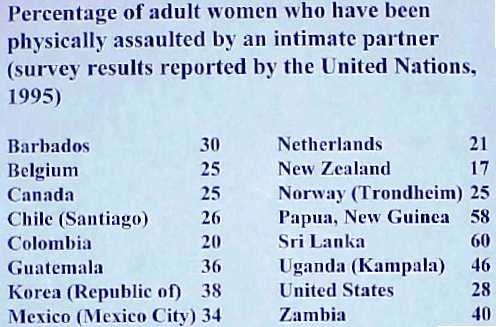 In
what country are women so vulnerable to violence from their husbands
that they bear it for years without leaving and without telling anyone
about it? This particular story happened in the African country of
Kenya. However, a perusal of the research on wife abuse will show
that it could have happened absolutely anywhere that this is a very
common story in almost every country of the world. While it is very
difficult to obtain accurate estimates of the frequency of domestic
violence, surveys in various countries suggest that the percentage
of women reporting physical abuse by a male partner may range from
a minimum (!) of about 17 to 25 percent (e.g., studies in New Zealand,
Canada, Belgium, the Netherlands, Norway) to a high of 55 to 60 percent
or more (e.g., studies in Japan, Ecuador, Sri Lanka, Tanzania, some
parts of Mexico and of India) (Neft & Levine, 1997). In
what country are women so vulnerable to violence from their husbands
that they bear it for years without leaving and without telling anyone
about it? This particular story happened in the African country of
Kenya. However, a perusal of the research on wife abuse will show
that it could have happened absolutely anywhere that this is a very
common story in almost every country of the world. While it is very
difficult to obtain accurate estimates of the frequency of domestic
violence, surveys in various countries suggest that the percentage
of women reporting physical abuse by a male partner may range from
a minimum (!) of about 17 to 25 percent (e.g., studies in New Zealand,
Canada, Belgium, the Netherlands, Norway) to a high of 55 to 60 percent
or more (e.g., studies in Japan, Ecuador, Sri Lanka, Tanzania, some
parts of Mexico and of India) (Neft & Levine, 1997).
While there is a disheartening
universality to the statistics on violence against women worldwide,
the violence can take different forms in different cultures, and I
think it is worth looking at these differences. For example, I spend
some time focusing on the institutionalization of wife-murder in certain
cultures:
Institutionalized wife-murder
*for money: dowry deaths
in India. One country in which the notion of marriage
as an economic arrangement is still strong is India, where parents
may sometimes literally bribe men to marry their daughters. It is
socially shameful and often economically distressing to have a daughter
for whom a suitable husband cannot be found, so parents entice potential
bridegrooms with promises of dowries of cash and/or household goods.
Frequently, in fact, parents go deeply into debt to marry off their
daughters. However, even after the marriage has taken place, a husband's
family may be unsatisfied with the dowry. They may pressure the new
wife to get more goods from her parents, making her life miserable
with insults and harassment if she is unwilling or unable to do so
(Narasimhan, 1994). The young woman must endure the suffering because
she cannot leave the marriage without bringing severe disgrace on
her family and herself.
Such situations often end with
the death of the new bride. Sometimes, in desperation because the
mistreatment has become unbearable, she commits suicide. Often, however,
she is murdered: doused with kerosene by her in-laws and set on fire.
The death is reported to authorities as a "kitchen accident"-- an
explanation that has some surface plausibility because middle-class
homes often use kerosene stoves for cooking. In 1995, the Indian government
reported 7,300 such "dowry deaths" (Neft & Levine, 1997).
A 1961 law prohibiting dowries
appears to have had little effect in the face of strong traditions
and the difficulty of proving what happened. A more stringent law,
passed in 1986, states that, in every unnatural death of a woman during
the first seven years of marriage, the husband or in-laws must be
presumed responsible by the courts. Yet convictions under this law
are rare, and dowry deaths continue to increase.
*for "honor": "honor
killings": A strong tradition exists, discernible in
many societies, that if a woman "dishonors" her husband (or sometimes
her father) by becoming sexually involved with man to whom she is
not married, it is legitimate for her to be killed. The buried remnants
of such a tradition can be found in North America, where a husband
who kills his wife in a "jealous rage" after discovering her adultery
may in some communities be regarded with more sympathy than outrage.
The tradition is more obvious, and reflected in the legal system,
in certain other countries.
In a famous case in Brazil, a man
arrived at a hotel where his wife was staying with another man and
asked the bellman to bring him to the couple's room. When the wife's
lover opened the door at the bellman's request, the husband stabbed
him repeatedly in the chest, killing him. The wife ran naked from
the room and into the street, where she was pursued by her husband,
caught, and stabbed to death.
An all-male jury accepted the argument
that the husband in this case had acted in legitimate defense of his
wounded honor and acquitted him of the double murder. The decision
, after being upheld by an appeals court, was later overturned by
Brazil's highest court, the Superior Tribunal of Justice. The Tribunal
ordered a new trial, noting that murder could not be considered a
legitimate response to adultery and that "what is being defended in
this type of crime is not honour but 'self-esteem, vanity and the
pride of the lord who sees his wife as property'." (Thomas, 1994,
p. 33).
Feminist activists in Brazil, who
had for decades been fighting to de-legitimate the "honor defense"
and the proprietary attitudes toward women underlying it, were buoyed
by this decision. However, when the new trial was conducted in 1991,
the husband was once again acquitted of the double killing on the
grounds that he had been legitimately defending his honor. Thus, in
Brazilian culture, wife murder was still considered an appropriate
response to alleged unfaithfulness; a husband could kill his wife
with impunity under such circumstances.
"Honor killings" to wipe away the
shame brought to a husband, father or brother by a female relative's
premarital or extramarital sex are a part of life in certain parts
of the Islamic world. In Palestinian villages, according to some estimates,
about 40 women a year die at the hands of a male relative who then
becomes a hero for clearing his family name. This type of killing
is not necessarily done in a rage, but is planned and premeditated.
An errant daughter or wife may be lured home with the promise that
all is forgiven, then cold-bloodedly murdered. Such killings also
happen in other Arab countries such as Saudi Arabia and Sudan, and
even sometimes among families who have emigrated to non-Muslim countries
(Brooks, 1995). Furthermore, although they are not legally sanctioned,
wife-murders that arise from jealousy, outraged pride, or wounded
egos, certainly happen with some frequency in most countries, including
the United States and Canada. In both countries, wives are the most
frequent victims of fatal violence in families and such fatal violence
is most likely to occur when the woman tries to leave an abusive husband.
Other forms of violence against
women can also be discussed in a global framework; for example, there
is widespread evidence of the prevalence of rape in many countries.
[OVERHEADS: Not available}
Common themes?
While some stories of male violence
against the women in their families are more horrific than others,
I try to get my students to see some common themes that run through
them:
| |
-the woman
is considered the man's property;
-the man is believed entitled to wield authority over the woman
and to punish her if she defies this authority;
-the family is viewed as a private institution where the man
rules and outsiders should not interfere;
-the woman is regarded as inferior to the man. |
These patriarchal cultural attitudes
emerge in the courtship violence documented in certain countries,
in the wife-beatings that occur all over the world, in dowry deaths
and honor killings. These attitudes are woven into the fabric of many
cultures, although their expression is more subtle in some times and
places than others and some individuals have been socialized with
a stronger "dose" of them than others in their culture. The point
of exposing students to the variety of forms that anti-female violence
can take is not to illustrate how bad "other" cultures are, but to
show how social-environmental factors can shape such behavior, and
how some of the same themes can be identified in various guises.
From a global, multicultural examination
of violence against women, students can learn that suchbehavior is
possible anywhere, but that it is shaped by culture. The social and
culturalenvironment, through the promulgation of particular attitudes
and values about families, shape the likelihood that children will
be raised in families where they witness or are victims of violence.
Similarly, culture shapes attitudes about the legitimacy of male domination
and female subordination, and about the social acceptability of using
violence in many situations. Will thepolice respond to and take seriously
a charge of spousal violence? If not, the abuser has more power. As
well, the availability of alternatives in the social environment affects
the power that the victim of violence has to leave the relationship.
Are there shelters for victims of abuse? Can a woman live safely on
her own? If not, the abuser has more power. Thus, power in interpersonal
relationships is, to some extent, shaped by the values and attitudes
promoted in the sociopolitical and cultural environment.
D. Gender and Political Power
 Women have occasionally headed countries as monarchs: for instance,
Queen Elizabeth I and Queen Victoria of England, Catherine the Great
of Russia. However, the first woman elected to lead a nation appears
to have been Sirimavo Bandaranaike, who became prime minister of what
is now Sri Lanka (then called Ceylon) in 1960. From 1960 until 1997,
31 women around the world were elected or appointed as heads of state
(Neft & Levine, 1997). If you have not heard of many of them, it is
because, for some, their terms of office were extraordinarily short.
For example, Kim Campbell, Sylvie Kinigi, Edith Cresson and Ertha
Pascall-Trouillot were, respectively, Prime Ministers of Canada, Bolivia,
France and Haiti for less than a year.
Women have occasionally headed countries as monarchs: for instance,
Queen Elizabeth I and Queen Victoria of England, Catherine the Great
of Russia. However, the first woman elected to lead a nation appears
to have been Sirimavo Bandaranaike, who became prime minister of what
is now Sri Lanka (then called Ceylon) in 1960. From 1960 until 1997,
31 women around the world were elected or appointed as heads of state
(Neft & Levine, 1997). If you have not heard of many of them, it is
because, for some, their terms of office were extraordinarily short.
For example, Kim Campbell, Sylvie Kinigi, Edith Cresson and Ertha
Pascall-Trouillot were, respectively, Prime Ministers of Canada, Bolivia,
France and Haiti for less than a year.
Women have been an increasing presence
in national legislatures worldwide. However, there is no nation in
which women hold half of such posts. Currently, the countries in which
women hold the highest percentage of seats in national legislatures
are Sweden (41%), Norway (39%), Finland (34%) and Denmark (33%). Canada
(19%) and the United States (11%) are far lower; many other countries
are lower still (e.g., France and Singapore have 5%; Iran and Kenya
have 4%; Somalia and Kuwait have none). [OVERHEAD - WOMEN
IN MINISTERIAL LEVEL POSITIONS - Slide Not available]
I have been doing some cross-cultural
research on women's perceptions of their possible selves as political
leaders and holders of other powerful positions, and one of the things
that is clear from this research is that young women in the United
States and in other countries feel that power and femininity do not
go together easily there is a tension between the two.
This is not surprising, given the
literature on gender stereotypes that we have just examined, and given
the shortage of female leaders who are available to act as role models.
Young women in countries such as the United States, Spain, and Argentina
are apparently aware of the tension between the requirements of femininity
and power. When asked to describe what they would be like if they
held powerful positions such as political leadership or corporate
presidencies, many female university students in these countries viewed
political leadership as an unlikely possibility for them. They also
stressed that, should they ever hold such a position, they would try
to balance the requirements of femininity and power: they would be
compassionate even though powerful, kind to subordinates even though
demanding, nice even though tough (Lips, 1996; Lips, de Verthelyi,
& Gonzalez, 1996). Some worried that others would not like them in
these roles a worry that, given the media reactions to female politicians,
seems well-founded. A sampling of their comments appears in the OVERHEAD.
When respondents in the United
States and Spain were asked for men's thoughts about powerful women,
those from both countries listed negative attributes: "more obsessed
[than men] in reaching power," "pedantic and authoritarian," "[they]
try to have power like men do, but without doing it like real women"
(Diaz Zuniga, Sattler, & Lips, 1997).
Whereas our research shows commonalities
among samples of women in different cultures, it also shows differences.
For example, women in our U.S. sample anticipated more relationship
problems associated with being a political leader than their male
counterparts did. However, in our sample from Spain, the women did
not anticipate any more problems than the men did and were significantly
less likely than U.S. women to mention the possibility of such problems
(Back, Diaz & Lips, 1996). In a comparison of another mainland U.S.
(Virginia) sample with a sample of women from Puerto Rico, we found
that, while the women from both samples anticipated the same level
of relationship problems associated with powerful positions, only
for the Virginia sample was such anticipation linked to a stated lower
likelihood that they could achieve such a leadership position (Lips,
1998).
It is not surprising that women
in different cultures share, to some extent, ambivalent feelings about
becoming political leaders. But what cultural factors may influence
the differences the ways women react to this possibility?
We have postulated that some of
the differences between the mainland U.S. samples and those in Spain
and Puerto Rico may be related to cultural differences on the dimension
of independence-interdependence (Markus & Kitayama, 1991). Mainstream
U.S. culture is apparently one of the most independence-oriented cultures,
emphasizing a notion of the self as unique and separate. Latin American
cultures and Spain, on the other hand, are sometimes found to be more
interdependence-oriented, emphasizing a sense of self that encompasses
various communities of which the individual is a part: family, work
groups, friendship groups. In the more independence-oriented culture
of the U.S. mainland, then, women may be likely to feel more individually
responsible for making their relationships work, and to feel pressure
and blame when they do not. In the more interdependence-oriented cultures
of Spain and Puerto Rico, however, women may be more secure in certain
of their core relationships, allowing them to contemplate conflict
that may occur in others.
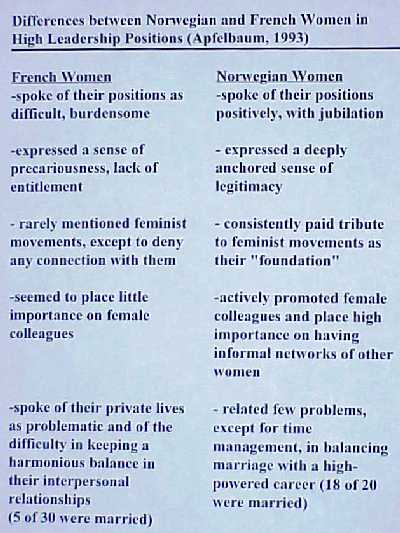 Erica
Apfelbaum (1993) investigated some ways in which the particular form
taken by women's experience of occupying a leadership position is
shaped by her culture and her times. Apfelbaum conducted in-depth
interviews with 50 women leaders in France and Norway. She discovered
that in these two western European countries, powerful women reported
very different experiences. Here are some of the differences she found
between the two samples; Erica
Apfelbaum (1993) investigated some ways in which the particular form
taken by women's experience of occupying a leadership position is
shaped by her culture and her times. Apfelbaum conducted in-depth
interviews with 50 women leaders in France and Norway. She discovered
that in these two western European countries, powerful women reported
very different experiences. Here are some of the differences she found
between the two samples;
In France, the women leaders spoke
of their lives as difficult, burdensome and filled with conflict and
suffering. In Norway, by contrast, the women spoke of their roles
positively and with jubilation, ETC. It appears that leadership
and power mean different things to the women in these tow countries.
What could account for the differences
in tone between powerful women in these two countries? [OVERHEAD:
Not Available] Part of it can be explained by the differing
history of the two countries. Power for women is a much older and
more established idea in Norway than in France. Norwegian women obtained
the vote in 1913, had women representatives in local assemblies beginning
in 1967, and have consistently had the support of major political
parties in their push to gain equality. It is a country in which a
woman has been Prime Minister in three different governments and in
which 39 percent of cabinet posts are held by women. In France, women
did not win the right to vote until 1944, and they still hold only
a small proportion of legislative seats and 13 percent of cabinet
posts. The few token women in high positions are used as examples
to "prove" that women are represented at all levels and to discourage
further claims.
Clearly, the presence of women
who have broken ground as pioneers and role models changes the social
landscape for the women who come later, providing them with a legacy
of increased confidence and legitimacy. In France, Apfelbaum noted
that the women leaders who had obtained their positions in the 1980s
were more optimistic and less lonely than those who had obtained their
positions in the previous decade. In Norway, where women had a longer
history of role models on which to draw, the women "expressed a deeply
anchored sense of legitimacy that was totally alien to French women
of the first generation and just evolving for the second" (Apfelbaum
1993, p. 419).
Cultural attitudes about power
may also help to explain the differing experiences of Norwegian and
French women in leadership positions. In Norway, political life apparently
revolves around the idea of "turnover" the idea that power is transitory,
and that a leader easily "passes the torch" to a successor. The power
built into a leadership position is not a core part of the leader's
identity. Thus, men may not be very threatened by the notion of sharing
leadership with women. In France, on the other hand, the political
power structure is strongly identified with men, and there is no comparable
notion of easy turnover (Apfelbaum, 1993).
Perhaps as a result of the sociohistorical
differences between their two countries, Norwegian and French women
leaders differed dramatically in two other ways: their allegiance
to feminist movements, and the ease with which they combined their
high-profile positions with marriage. Norwegian women leaders of all
political persuasions consistently paid tribute to feminist movements
as "the foundation from which emerged the means to fight for the integration
of women in the public arena" (Apfelbaum, 1993, p. 421). The French
women, on the other hand, did not mention feminist movements except
for the purpose of denying any connection with them. Congruent with
these differing emphases on feminism, Norwegian women were much more
likely than French women to actively promote their female colleagues,
to respond actively and combatively to sexual harassment and everyday
sexism, and to place high importance on the friendship and support
provided by informal networks of other women.
The casual observer might think
that these combative, feminist-oriented Norwegian women would be less
likely than their French counterparts to be able to maintain their
close relationships with men. Nothing, found Apfelbaum (1993), could
be further from the truth. While 18 of the 20 Norwegian women were
married when interviewed, only five of the 30 French women were. Most
of the Norwegian women claimed to have had few problems balancing
marriage with their high-powered career, except for the logistical
ones involving time management. However, the French women were less
sanguine about their private lives. "Almost without exception, they
spontaneously raised the issue of their private life as a problematic
one and spoke at length about the burdens, the tensions and the difficulty
of keeping a harmonious balance in their interpersonal relations with
their companions. In this domain, they seemed vulnerable and insecure:
The danger of losing a companion was omnipresent, and deep down they
knew that being single was the price they might have to pay. French
men still seem unable to cope with the social comparison involved
once their wives become too visible." (Apfelbaum, 1993, p. 423). Apfelbaum
notes that the French tradition of male-female intimate relationships
is strongly based on romance, seduction, chivalry, and game-playing
all of which involve notions of conquest and dominance and of unequal
positions between women and men. Perhaps, she speculates, such cultural
traditions mitigate against the easy acceptance in France of relationships
in which the woman is visibly more powerful than the man.
The contrast between the leadership
experience for women in Norway and France suggests that holding power
is likely to involve major social and personal sacrifices for women
unless it is done within a cultural context where female leadership
is not unusual and female political participation is strong. It also
suggests, however, that such a context may be more difficult to achieve
in some cultures than in others. Given the discrepancies in the leadership
experiences of women from two western, European democracies, we can
only begin to glimpse the possible differences in the experiences
of women whose cultures diverge even more widely.
In Conclusion:
I have tried to show how the incorporation
of different cultural perspectives can help students to understand,
on many levels, that gender is to a large extent what societies make
it and that cultures construct the meanings that individuals attribute
to their experiences. The point is not to have students learn everything
about gender or women in every culture, but to get a feel for the
range of similarities and differences that exist across cultures.
In closing, I would like to make
one final recommendation: that students in these courses be exposed
to first-person accounts, or life stories, of women (and men, for
courses on gender) in a variety of cultures. The stories make the
issues real, provide touchstones for remembering some of the points
and principles, and perhaps most important, help them to see the world
from alternative points of view in ways that few of us can accomplish
in the classroom. I've provided a list of possible sources of such
first person accounts, and I hope you will find them useful.
If we try to teach with an eye
to multicultural perspectives, we will never be satisfied that we
have given completely adequate treatment to any issue, we will never
be done with broadening our own horizons. Each turn of the kaleidoscope,
after all, provides a new vision, a new combination of shapes, colors,
and designs. Our challenge is to stay open to many different visions,
to resist our own desire for closure, that impatient desire for the
quick "right answer" that we find so frustrating in our students.
The rewards for doing so are a psychology of women and gender indeed,
an entire field of psychology that focuses on the world instead of
only a small part of it, and students who are aware that their worldview
is not the only one possible. The women that I described at the beginning
of this talk Amelia Edwards, Bessie Coleman, Mae Jemison, Rigoberta
Menchú-- took enormous physical and emotional risks to leave
behind their cultural blinders. Surely, we can take some intellectual
ones. |
Presentation
Scenes
|
|




 Currently,
we look mainly at white, middle-class U.S. women and men in our courses
on the psychology of women and gender. How can we separate what goes
with being female or male from what goes with being white, middle-class,
American? We cannot. And this makes it look as though certain qualities
or behaviors that correlate with being female or male in this culture
are inevitably linked to sex or to gender. The title for this talk
was suggested by a quote from Australian literary scholar Sneja Gunew:
In trying to grasp the experiences of women from a variety of times
and places, "we should perhaps use the image of a kaleidoscope, where
each turn produces different patterns and no single element dominates"
Sneja Gunew (1991).
Currently,
we look mainly at white, middle-class U.S. women and men in our courses
on the psychology of women and gender. How can we separate what goes
with being female or male from what goes with being white, middle-class,
American? We cannot. And this makes it look as though certain qualities
or behaviors that correlate with being female or male in this culture
are inevitably linked to sex or to gender. The title for this talk
was suggested by a quote from Australian literary scholar Sneja Gunew:
In trying to grasp the experiences of women from a variety of times
and places, "we should perhaps use the image of a kaleidoscope, where
each turn produces different patterns and no single element dominates"
Sneja Gunew (1991). Men measure a woman's attractiveness by her obesity, and a young woman
is prepared for marriage in ways guaranteed to "fatten her up": the
least possible activity and the most possible food. By the time of
her marriage, the young woman may be so fat that she cannot walk,
only waddle. At the wedding, onlookers then will comment on how beautiful
she is, noting with approval the cracks in her skin caused by the
fatness and the difficulty with which she walks. Once married, a wife
is kept fat by consuming surplus milk from the herd -- often coerced
to do so by her husband when she has long past the point of satiation.
The wife leads a life of "leisure." She is assigned no heavy physical
work, rarely leaves home, spends her days in sexual liaisons with
a variety of men approved by her husband. These sexual relationships
cement economic ones: the obese, conspicuously consuming wife is both
a symbol and an instrument of her husband's economic prosperity (Tiffany,
1982).
Men measure a woman's attractiveness by her obesity, and a young woman
is prepared for marriage in ways guaranteed to "fatten her up": the
least possible activity and the most possible food. By the time of
her marriage, the young woman may be so fat that she cannot walk,
only waddle. At the wedding, onlookers then will comment on how beautiful
she is, noting with approval the cracks in her skin caused by the
fatness and the difficulty with which she walks. Once married, a wife
is kept fat by consuming surplus milk from the herd -- often coerced
to do so by her husband when she has long past the point of satiation.
The wife leads a life of "leisure." She is assigned no heavy physical
work, rarely leaves home, spends her days in sexual liaisons with
a variety of men approved by her husband. These sexual relationships
cement economic ones: the obese, conspicuously consuming wife is both
a symbol and an instrument of her husband's economic prosperity (Tiffany,
1982). According to one survey, these women were not rich about half made
less than $25,000 per year, and took out loans to pay their surgery
bill. Many women undertook the dangers and heavy costs of surgery
in order to achieve or try to maintain a standard of beauty they felt
necessary for attracting or holding a man. Where did they get the
idea that such drastic measures might be necessary? From millions
of magazine advertisements featuring impossibly-shaped women, and
from the countless "personal" ads in which men specified that they
were looking for a woman who was "attractive and thin" (Smith, Waldorf,
& Trembath, 1990). A representative survey of more than 800 adult
U.S. women in 1995 showed that women held substantially higher levels
of dissatisfaction with their bodies than had been observed in a similar
survey a decade before and nearly half the women reported overall
negative evaluations of their appearance (Cash & Henry, 1995).
According to one survey, these women were not rich about half made
less than $25,000 per year, and took out loans to pay their surgery
bill. Many women undertook the dangers and heavy costs of surgery
in order to achieve or try to maintain a standard of beauty they felt
necessary for attracting or holding a man. Where did they get the
idea that such drastic measures might be necessary? From millions
of magazine advertisements featuring impossibly-shaped women, and
from the countless "personal" ads in which men specified that they
were looking for a woman who was "attractive and thin" (Smith, Waldorf,
& Trembath, 1990). A representative survey of more than 800 adult
U.S. women in 1995 showed that women held substantially higher levels
of dissatisfaction with their bodies than had been observed in a similar
survey a decade before and nearly half the women reported overall
negative evaluations of their appearance (Cash & Henry, 1995). Thus,
they used terms such as "man-woman" and "halfman-halfwoman" to translate
the Indian terms for such individuals: nadle, winkte, heemaneh.
Yet it now appears that these translations were misleading, limited
by the anthropologists' own notions of gender. Instead, the terms
seem to describe a distinct third gender -- one that is not simply
a mixture of masculine and feminine, but defined separately from them
(Callender & Kochems, 1983; Fulton & Anderson, 1992). The person is
not a man dressing and acting like a woman, nor a woman dressing and
acting like a man, but a man or woman who has adopted a third role
-- that is neither feminine nor masculine.
Thus,
they used terms such as "man-woman" and "halfman-halfwoman" to translate
the Indian terms for such individuals: nadle, winkte, heemaneh.
Yet it now appears that these translations were misleading, limited
by the anthropologists' own notions of gender. Instead, the terms
seem to describe a distinct third gender -- one that is not simply
a mixture of masculine and feminine, but defined separately from them
(Callender & Kochems, 1983; Fulton & Anderson, 1992). The person is
not a man dressing and acting like a woman, nor a woman dressing and
acting like a man, but a man or woman who has adopted a third role
-- that is neither feminine nor masculine.

 In
what country are women so vulnerable to violence from their husbands
that they bear it for years without leaving and without telling anyone
about it? This particular story happened in the African country of
Kenya. However, a perusal of the research on wife abuse will show
that it could have happened absolutely anywhere that this is a very
common story in almost every country of the world. While it is very
difficult to obtain accurate estimates of the frequency of domestic
violence, surveys in various countries suggest that the percentage
of women reporting physical abuse by a male partner may range from
a minimum (!) of about 17 to 25 percent (e.g., studies in New Zealand,
Canada, Belgium, the Netherlands, Norway) to a high of 55 to 60 percent
or more (e.g., studies in Japan, Ecuador, Sri Lanka, Tanzania, some
parts of Mexico and of India) (Neft & Levine, 1997).
In
what country are women so vulnerable to violence from their husbands
that they bear it for years without leaving and without telling anyone
about it? This particular story happened in the African country of
Kenya. However, a perusal of the research on wife abuse will show
that it could have happened absolutely anywhere that this is a very
common story in almost every country of the world. While it is very
difficult to obtain accurate estimates of the frequency of domestic
violence, surveys in various countries suggest that the percentage
of women reporting physical abuse by a male partner may range from
a minimum (!) of about 17 to 25 percent (e.g., studies in New Zealand,
Canada, Belgium, the Netherlands, Norway) to a high of 55 to 60 percent
or more (e.g., studies in Japan, Ecuador, Sri Lanka, Tanzania, some
parts of Mexico and of India) (Neft & Levine, 1997). Women have occasionally headed countries as monarchs: for instance,
Queen Elizabeth I and Queen Victoria of England, Catherine the Great
of Russia. However, the first woman elected to lead a nation appears
to have been Sirimavo Bandaranaike, who became prime minister of what
is now Sri Lanka (then called Ceylon) in 1960. From 1960 until 1997,
31 women around the world were elected or appointed as heads of state
(Neft & Levine, 1997). If you have not heard of many of them, it is
because, for some, their terms of office were extraordinarily short.
For example, Kim Campbell, Sylvie Kinigi, Edith Cresson and Ertha
Pascall-Trouillot were, respectively, Prime Ministers of Canada, Bolivia,
France and Haiti for less than a year.
Women have occasionally headed countries as monarchs: for instance,
Queen Elizabeth I and Queen Victoria of England, Catherine the Great
of Russia. However, the first woman elected to lead a nation appears
to have been Sirimavo Bandaranaike, who became prime minister of what
is now Sri Lanka (then called Ceylon) in 1960. From 1960 until 1997,
31 women around the world were elected or appointed as heads of state
(Neft & Levine, 1997). If you have not heard of many of them, it is
because, for some, their terms of office were extraordinarily short.
For example, Kim Campbell, Sylvie Kinigi, Edith Cresson and Ertha
Pascall-Trouillot were, respectively, Prime Ministers of Canada, Bolivia,
France and Haiti for less than a year. Erica
Apfelbaum (1993) investigated some ways in which the particular form
taken by women's experience of occupying a leadership position is
shaped by her culture and her times. Apfelbaum conducted in-depth
interviews with 50 women leaders in France and Norway. She discovered
that in these two western European countries, powerful women reported
very different experiences. Here are some of the differences she found
between the two samples;
Erica
Apfelbaum (1993) investigated some ways in which the particular form
taken by women's experience of occupying a leadership position is
shaped by her culture and her times. Apfelbaum conducted in-depth
interviews with 50 women leaders in France and Norway. She discovered
that in these two western European countries, powerful women reported
very different experiences. Here are some of the differences she found
between the two samples; 
